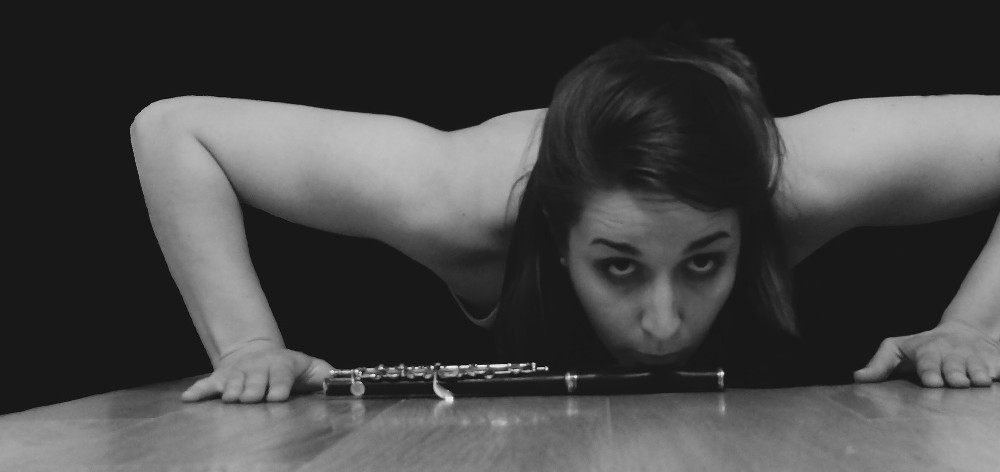Kathryn Williams

Kathryn Williams is a flautist and educator based in the UK. Earlier this month at Kammer Klang she performed selections from Coming Up for Air, a series of single-breath pieces written for her by different composers. The series emerged as a response to her experience of asthma and a chronic sinus condition, and now includes over 100 pieces.
I wanted to start by asking about how the pieces have been commissioned and written. It feels like a very open and social process. How have different composers approached it?
Coming Up for Air was originally 14 single-breath pieces from friends who generously took part. I then instigated an open call online, which has boosted the collection to over 120 pieces. The whole process has been really varied. With the open call, some pieces just land into my email already completed, and sometimes I’m asked to try out a range of ideas first. I always offer a recording and some feedback to every submission.
There are pieces which engage mainly with instrumental playing: the decay of sound, for example, when I run out breath. There are pieces which use the suspension of breath – that’s when I temporarily stop the process of inhaling or exhaling, which makes pieces quite a bit longer. And there are pieces which factor in environmental constraints, so this is kind of taking away the focus on the breath, or the instrument, by imitating sounds that might be listened to, or environmental constraints to breathing. Such as Andy Ingamells’ and my piece, which we filmed in the swimming pool at a local leisure centre. I have noticed though that many pieces only focus on exhaled material, which is actually only 50% of the piece. So now I’m trying to stipulate that there is at least an instruction or an engagement with what type of inhale goes with the piece.
Some of the most exciting pieces are the ones that come from unexpected places, such as teaching teenagers on a composition course, or just through conversations. Sometimes single-breath pieces are like seeds that can grow into larger-scale collaborations. Like with Annie Hui-Hsin Hsieh, where her PIXERCISE was just me doing as many sit-ups as possible while playing the highest note possible on the piccolo, and it’s turned into a really large-scale collaboration where I’ve been training for 10 months and it’s now a 20-minute exercise piece.
The whole project really is an invitation for composers to think about their own relationship with their bodies, breath and music-making. It’s been really incredible so far to connect with so many musicians from around the world.
You mention the body. How much of the project do you think connects with the current interest in questioning what performance is about (e.g. foregrounding the performer as a human body and human subject)?
Single-breath pieces were partly initiated through the frustrations I had when phrases were too long for my body, when my respiratory conditions were at their most severe. These are bespoke pieces created for my breath, but I’m curious about how other flautists will sound playing them. There is a great deal of tension from both sides when the audience knows that pieces are to be performed in one breath; there is no room for error when the inhale and exhale must be so precisely spent. My breath often lasts significantly longer in live performance than in practice, so it can be infuriating trying to prepare some of these pieces when my body just can’t make it until it’s performed live!
In PIXERCISE, the sounds made through the piccolo are only possible by me performing various exercise moves, the first move being a forearm plank. The piccolo is taped onto a box around six inches high so that my mouth naturally rests on the headjoint while I am holding myself up in the plank position. I exhale into the piccolo for as long as possible, which lasts around 45 seconds. I played a recording of just this sound in a composition workshop recently and asked the group how they thought it was notated. Several guesses included a line for embouchure position, half or three-quarters breath, or fine microtones. When I told them the truth, there was a moment of astonishment and then the group was able to laugh a bit at themselves.
Much of written music assumes a great deal about the human being realising it. It is definitely cleaner and less leaky to ignore the human behind the instrument. I hope that in some way, my invitation to make single-breath pieces will bring back bodies into subsequent compositions.
One thing I really enjoyed in your set was how the pieces interlaced these different permutations of what a breath can be and do: a temporal frame but also a biophysical act or even something like an act of ritual (like in Eleanor Cully’s pieces). How did you go about assembling the sequence of pieces?
I’ve performed short sets of six to 10 single-breath pieces plenty of times and usually the tension holds naturally for that length of time to go from piece to piece without applause. When putting together my 20-minute set to include 24 single-breath pieces I wanted to treat it like one long piece of sequential breaths, using the space creatively. I had to consider how physically demanding some of the pieces are and how long recovery takes when putting them in order (this is why Mark Dyer’s Memento for Kathryn was last in the concert, as it stretches one breath to two minutes and 20 seconds). There are some overarching and overlapping categories for these pieces, at least how I’ve read them, which also feeds into my primary concept of creating something diverse, effective and practical. There are pieces which focus on the body, instrument or environment and pieces which address biographical concerns. I tried to make coherent connections between these throughout the set.
I had three different areas of the stage dedicated to three groups of pieces respectively. Each group began with a wish-making piece from Eleanor Cully (first on cotton grass, second on fairy dust, and third on a birthday candle which was blown out by a member of the audience who had a recent birthday). I used Stephen Chase and Amber Priestley’s pieces to travel to the next location – Stephen’s piece has me leaping across the room and I have to walk alongside Amber’s nine-foot-long score while playing it. I also included three films, both so that I had time to recover and so I could show pieces that are (nearly) impossible to perform live. Andy Ingamells’ and my piece is to be played in a swimming pool and Charlotte Marlow’s piece is so intimate that it only shows my mouth.
One of the great pleasures of this project is that pieces come from all walks of life and all ages. This set contained eight world premieres, which is typical for the project, as pieces are often coming in and composers write more than one piece. Some of these pieces are collaborations that are agonised over for months, and others are written minutes before the performance.
Kathryn Williams
Kathryn Williams is a flautist and educator based in the UK. A core member of The House of Bedlam, she has also performed with Distractfold Ensemble, Ensemble Voix Nouvelle, Ensemble 360, BBC Philharmoinc, The Hallé, Sinfonia Cymru, Royal Liverpool Philharmonic, and concertos with Manchester Camerata, Dayton Philharmonic, and Royal Northern College of Music Symphony Orchestra and Wind Ensemble.
As a music educator Kathryn specialises in experimental performance practice and early-years education. Recently this has included guest lecturing at the Royal Northern College of Music and Ohio State University, contributing to courses for Aldeburgh Young Musicians and National Youth Orchestra of Great Britain, and long-term residencies at Alder Hey Children’s Hospital, Manchester Museum, and a central Manchester nursery. Working for organisations including Live Music Now, Peoplescape Theatre, Theatre in Prisons and Probation, and Music in Hospitals, Kathryn regularly devises and delivers performances and workshops in a wide variety of settings including care homes, museums, special-needs schools, prisons, and hospitals.
Kathryn earned a BMus, MMus, and International Artist Diploma from the Royal Northern College of Music and is currently studying for a PhD in Performance at Huddersfield University. Her current research, commissioning and performance project, Coming Up for Air, explores the creative possibilities that emerge when pieces are limited to one breath. Kathryn is also currently collaborating with composer Annie Hui-Hsin Hsieh in the development PIXERCISE, a new solo piece for piccolo and exercise which brings together musical performance, physical theatre, performance art, and sport.
Upcoming releases and performances include Oliver Coates Shelley’s on Zenn-La on RVNG International, Coming Up for Air on Huddersfield Contemporary Records/NMC, PIXERCISE at HCMF, and Coming Up for Air for the Kammer Klang series at Café Oto.
